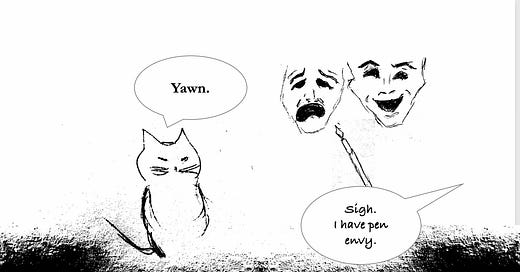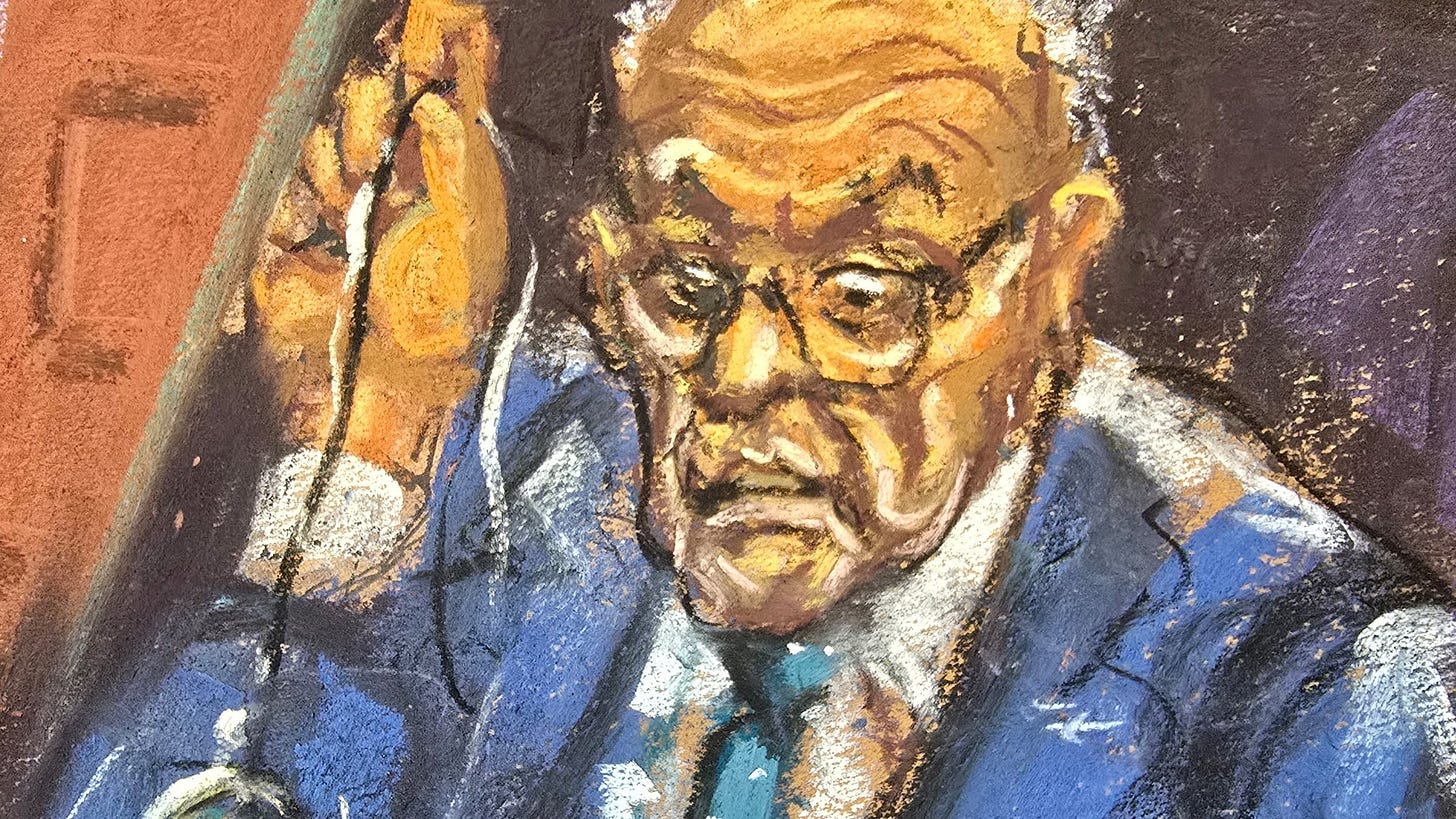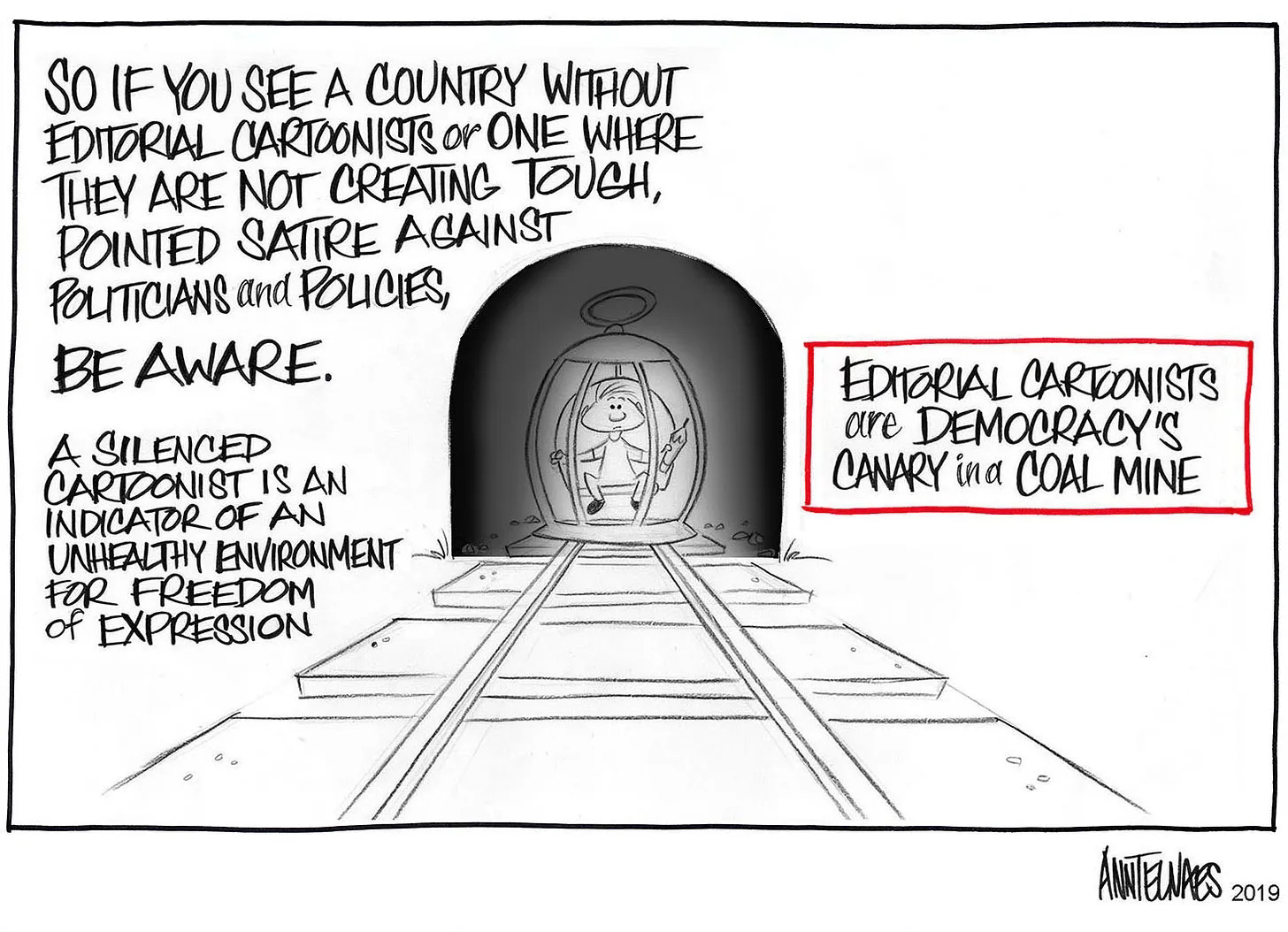Characters of Courage: Why We Need to Support Political Cartoonists
The pen is mightier than the sword - particularly when the artist wielding it can bring to life the truth beneath the surface.
This week, on Jan. 6, snow blanketed the DMV. Not the car inspection place - the DC, Maryland, and Virginia area. It felt fitting, as the snow, like many, whitewashed the shame of that day. Another whitewashing occurred with the censorship of political cartoonist
by her editors at the Washington Post.Like many of you, I was disillusioned and disappointed to learn her cartoon was killed by her boss. Her image depicted oligarchs and media chief executives currying favor with the incoming president.
A rough sketch of the Ann Telnaes npanel that was killed by WaPo editor.
You’d have thought her near 20-years tenure and Pulitzer Prizes would have protected Telnaes. But no, there is no safe space when a billionaire’s wallet is at risk.
The outrage has been astounding, and Telnaes has been touched by the uproar.1 Long-time colleague and peer
has encouraged visual artists to show their support by continuing to press the issue.2 We are fortunate to continue to have access to Telnaes’ creativity here on Substack. But what really moved me were some of her words:Over the years I have watched my overseas colleagues risk their livelihoods and sometimes even their lives to expose injustices and hold their countries’ leaders accountable. As a member of the Advisory board for the Geneva based Freedom Cartoonists Foundation and a former board member of Cartoonists Rights, I believe that editorial cartoonists are vital for civic debate and have an essential role in journalism.
Telnaes own colleague, her colleague, Jamal Khashoggi, gave his life in pursuing corruption within the Saudi Government. She never hid her thoughts on who was responsible.3
The talents of the visual artist are way beyond my abilities. I can make a hat. And render a not-bad illustration of a cat. Beyond that I am hopeless. And for that I have pen envy.
Since the election I have been hearing how Harris’ messaging was too difficult for people to process. It’s tough to give that complaint much credence given her opponent. However, when all of life is nuanced, black and white stands out for its high contrast. It’s not the messaging, I thought. It’s the delivery.
As a writer, as much as it pains me to admit, in a meme-filled society, nuance buried in 1000 words is seen as too much work. Messengers aren’t necessarily trusted. People need to see things with their own eyes. Which made me think of graphic novels and political cartoonists. I have been wishing I could draw this cabal of 47 supporters as either Dick Tracy criminals or all the bat-shit loonies in Batman.
My thoughts were reinforced when I hopped the Atlantic for a spur-of-the-moment trip to London a few weeks ago; a mom’s weekend with my son and his girlfriend. While there, the four of us went to the Imperial War Museum, and viewed the exhibit “Churchill in Cartoons: Satirising a Statesman.”4 It was a fascinating journey of both the power of cartoonists and the seemingly chameleon-like Churchill; albeit always corpulent and with a stogie. From dragon slayer to monster.5
Despite not being a huge comic book fan, I needed to know more about this art. I dug into two sources: Alice Loxton’s Uproar! and Tim Clayton’s James Gillray: A Revolution in Satire. Clayton is a scholar of text and images in 18th Century satire ––and focused on the technical innovations in mass communications. Gillray left the lucrative world of engraving - the predecessor of printing, for political caricature. No longer limited to black and white, Gillray’s illustrations were in color. His goal was to attack those who were strongest, and he skewered the royal families of both England and France.6
Their abilities to present their subjects so viscerally, public perception has long been swayed by those quick on the draw (with their pens). Through Loxton I learned that since the days of Leonardo di Vinci, artists who understood anatomy - and corresponding muscles in the face – are able to capture greed, avarice, fear, hatred, loathing. They bring their subjects to life warts and all. And they make us laugh.
During the Renaissance period, artists added animal features onto humans to emphasize certain, less than desirable qualities.7 It is in the exaggeration of grotesqueness that sits in people’s imaginations. Caricature has its roots in Bologna. Noted Baroque Artist Annibale Carracci and his brothers opened the Carracci Academy in the late 16th Century.
”Is not the caricaturist’s task exactly the same as the classical artist’s?
Both see the truth beneath the surface of mere outward appearance.”
— Annibile Carracci
Seeing the truth beneath the surface; and magnifying the truth so the rest of us sees it, too.
Drawings become truth - even when they’re meant figuratively.
I’m guilty of saying “the Napoleon complex” when I see a man of shorter stature being aggressive, and attribute it to his need to overcompensate. Noted Psychiatrist Alfred Adler8 coined the term in the 1950s in reference to a man feeling ashamed of his height.
But what might surprise you, is that Napoleon was of average height. The illusion he was short was conjured up by the brilliant British Cartoonist James Gillray. And it bugged Napoleon to no end.
In a world where hubris often eclipses accountability, where being in contempt (and contemptible) is worn as a badge, a drawing, not a legal reprimand, can strike a nerve.
This week, Rudy Giuliani found himself back in court and, predictably, back in trouble—this time for being held in contempt. But his real fury wasn’t directed at the judge’s ruling; it was aimed at courtroom artist Jane Rosenberg’s sketch. 'You made me look like a dog,' he bellowed, proving yet again the power of caricature to unmask egos.
That’s the power of caricature—it lays bare truths no words can fully capture.
A week after Ann Telnaes’ resignation, she reported that McClatchy publishing laid off three Pulitzer Prize winning artists, illustrating the news with an older panel of hers. 9
I don’t see these cartoonists as being silenced though. As in Gillray’s era, mass communications is going through another transformation. Newspapers are so last century. Their audiences have literally been dying off for years. All these truth tellers are now free from the whims of oligarchs and share holders. And it is incumbent upon us to support them.
In an era of misinformation and shrinking attention spans, political cartoonists cut through the noise with the power of a single image. Their art demands accountability and offers clarity in a world desperate for both. Supporting them isn’t just about preserving an art form—it’s about protecting the very foundation of civic discourse.
https://substack.com/home/post/p-154148171
https://www.washingtonpost.com/news/opinions/wp/2018/10/22/saudi-crown-prince-to-head-the-investigation-into-khashoggis-death/
https://www.iwm.org.uk/events/churchill-in-cartoons-satirising-a-statesman
A Nazi propagandist labeled him a “Monstre,” blaming him for food shortages in occupied Belgium. Smithonian. “See Winston Churchill Through the Eyes of the Political Cartoonists He Inspired.”
youtube.com/watch?v=WsMzXWcQtNM
Apparently AI learned from the masters when stitching a couple other fingers
https://www.adler.edu/alfred-adler-history/











As always, you are insightful, Diane. This also makes me think of how Jimmy Carter was lampooned during his presidency. He often was drawn as a big-toothed country bumpkin, reflecting his outside status in Washington. That was part of what got him elected in 1976 and a big part of why he was not elected in 1980 -- the American people had come to see him as a bumbling idiot. Honest, but ineffective. Those cartoons were powerful then and still are today.
Good point about our meme driven world Diane. And yes, newspapers can’t seem to compete with free “content.”
You might want to give Funny Times, a monthly anthology of cartoons and comic essays, a read. In tabloid format, it marries the old and the new: a paper meme.
The nod to Giuliani’s outburst was a sharp call. Nothing like mockery to get under a man-child’s skin.